Atlantis Massif Exp. 357 Off-shore
Brief final summary of Exp. 357:
During Expedition 357, a total of 57.13 m of core was recovered after 108.939m (including a short open hole section) of total penetration, and with an overall recovery of 52.84% at 17 holes at 9 different sites. Two holes were drilled to nearly 16.5 mbsf, with an average core recovery of 71-75%. Such high recovery in shallow mantle sequences is nearly unprecedented in the history of ocean drilling. The cored sections were highly heterogeneous, ranging from moderately to highly altered and deformed serpentinized peridotites, with varying compositions and occurrences of talc-amphibole schist zones. Less abundant lithologies included lithified basalt breccias, rodingites, and metagabbros with cataclastic to (ultra)mylonitic deformation fabrics. Thus, the cores recovered by seabed rock drilling along the east-west transect across the southern ridge of the Atlantis Massif record an intricate history of deformation, alteration and fluid flow.
In addition to recovering lower crustal and upper mantle sequences of the detachment fault zone of the Atlantis Massif, advancements in seafloor drill rig technology were achieved during Expedition 357. For the first time, two borehole plug systems were successfully installed. These borehole packers will enable future sampling of formation fluid from the boreholes to understand geochemical and microbiological processes in this actively serpentinizing system.
RPL team members Katrina Twing and Matt Schrenk participated in the Off-shore portion of Exp. 357 and kept us updated on their progress.
Update from Katrina Twing 11 Nov. 2015:
Greetings from the Atlantis Massif. After a long transit (~10.5 days), we arrived on site on November 5th and were eager to being our science! Before the drill is deployed at each site, we perform a CTD cast, from which aqueous geochemistry (bottom water only) and microbiology (water column) samples are collected. There are two drills on board, RD2 and MeBo, which can drill 50 and 70 meters of core, respectively, that will alternate between sites. For the last week, they have each been deployed multiple times, recovering variable lengths of core (2-20m), as the drill teams work out some kinks. This has kept us on our toes, as we never know when core might be coming back to the ship. The science team is divided into two shits (noon-midnight and midnight-noon) so that we are covered whenever the drill resurfaces. To date, we have collected roughly 200 L of seawater for background DNA samples and 30 m of core, including 230 cm set aside for microbiological analyses (including DNA/RNA, cell counts, and incubation experiments). We are currently drilling one of the high priority sites (very close to the Lost City) and are keeping our eye on the approaching tropical storm/hurricane Kate and hoping it doesn’t interrupt our operations.

RPL team members Matt Schrenk and Katrina Twing ready to embark on Expedition 357.

